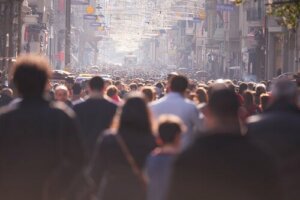Description and Characteristics of Tourism Phobia


Written and verified by the psychologist Andrés Navarro Romance
The term tourism phobia refers to the fear, aversion, and social rejection that some locals develop towards those who visit their cities. However, according to psychologist Sergio García Soriano, no empirical evidence in psychological literature supports it.
This is no clinical phobia per see. However, it doesn’t mean that the residents of a place don’t negatively respond to the massive arrival of tourists, especially if they display excessive behaviors or cause public scandals. But not all tourists are bad.
This condition is caused by the abuses this activity entails. This is because, like any other activity, it implies costs. Denying them is rejecting evidence. For example, the latest published survey on tourism in Venice, Italy shows that the impact of tourism is a cause of concern for its inhabitants.
What’s tourism phobia?
Tourism phobia is the social rejection of tourists by the citizens of a locality. Some of the most pernicious consequences of living in cities overflowing with tourists are:
- Not being able to rest at night.
- Paying exorbitant amounts for rent.
- The chain production of local crafts.
Thus, fewer and fewer residents continue to live in the city, and those who remain there do so because tourism is their livelihood. In fact, Orozo Alvarado and Quintero Santos (2008) argue that the colonization process of tourism can lead to all sorts of socio-cultural impacts in some destinations.

Why does tourism phobia only exist in some destinations?
Some massive destinations like the Canary Islands, the Dominican Republic, and Peru haven’t experienced this phenomenon despite all the tourists they welcome.
Perhaps it’s because their designs focus on tourism and the local citizenry is linked to this dimension of their country. Be that as it may, tourism hasn’t had a negative impact on their neighborhoods.
Rebelling against tourists
It’s common to hear news of some cities rebelling against the massive arrival of tourists. Barcelona, Rome, Palma de Mallorca, Venice, Berlin, Toronto, New Orleans, and some Asian cities have made themselves heard through social networks. They continuously express their discontent with tourism.
Tourism is a million-dollar industry. However, the massification of tourism can lead to coexistence problems, provoke the rise of housing prices, and destroy local business fabrics.
Changes in the local culture
The crafts produced in different places are often transformed into low-cost products, as people begin to manufacture them in bulk with the purpose of increasing their profits. They lose the roots of their heritage and cultural tradition as a consequence.
In order to satisfy mass tourism, people produce and commercialize similar articles at low prices. In fact, Asian factories are now in charge and they benefit from manufacturing these products.
Neighborhood actions
Vindictive paintings, neighborhood demonstrations, and protests in social networks try to make people aware that the problem of tourism massification is everybody’s business.
They also try to make people aware that neighborhoods and cities have few locals due to tourist accommodations, vacation apartments, and low-cost hotels.
While some businesses profit, others are forced to close their doors. As you can see, accommodating tourists has become a double-edged sword.
More and more property owners are renting their apartments to tourists in order to maximize profit. Unfortunately, a tourist pays in a week what a regular renter would pay in a month.
People develop tourism phobia when they see that finding a home in their town is nearly impossible
Searching for a home has become an arduous task when an area is crowded with tourists. This is leading to the transformation of many historical centers in big cities. In fact, if you take a walk through some main tourist spots, you’ll quickly discover that many stores have closed to make way for others destined for tourism.
The environmental impact of tourism
Some of the most negative environmental impacts of tourism are:
- The saturation of infrastructure and public services to accommodate indiscriminate urban growth.
- Architecture that doesn’t integrate into the landscape.
- Acoustic, atmospheric, and residual pollution.

Tourism phobia versus tourism quotas
Tourism is the main way of life in many cities around the world. The arrival of millions of tourists allows them to meet their economic needs. This is because tourists spend money in bars, stores, museums, accommodation, and transportation.
The most important thing is to be aware that regulating tourism is quite reasonable; every city must establish a maximum number of visitors.
This doesn’t mean destroying tourism but rather improving coexistence, ending speculation in housing rentals, and promoting a responsible, sustainable, and balanced model.
Everyone can continue enjoying their dream destinations as long as they do so responsibly!
All cited sources were thoroughly reviewed by our team to ensure their quality, reliability, currency, and validity. The bibliography of this article was considered reliable and of academic or scientific accuracy.
- Abril-Sellaré, M., Azpelicueta, M. C., & Sánchez-Fernández, M. D. (2015). Turismo sostenible: lugareños frente a turistas. El caso de la ciudad de Barcelona. Revista Holos, año 31, vol. 3, 331-337. DOI: https://doi.org/10.15628/holos.2015.2809.
- Álvarez Sousa, A. (2011). Sociología del turismo. Madrid: Centro de Estudios Financieros.
- Gordon, B. M. (2002). El turismo de masas: un concepto problemático en la Historia del siglo XX. Historia Contemporánea, 25, 125-156. Disponible en http://www.ehu.es/ojs/index.php/HC/article/view/5928
This text is provided for informational purposes only and does not replace consultation with a professional. If in doubt, consult your specialist.








